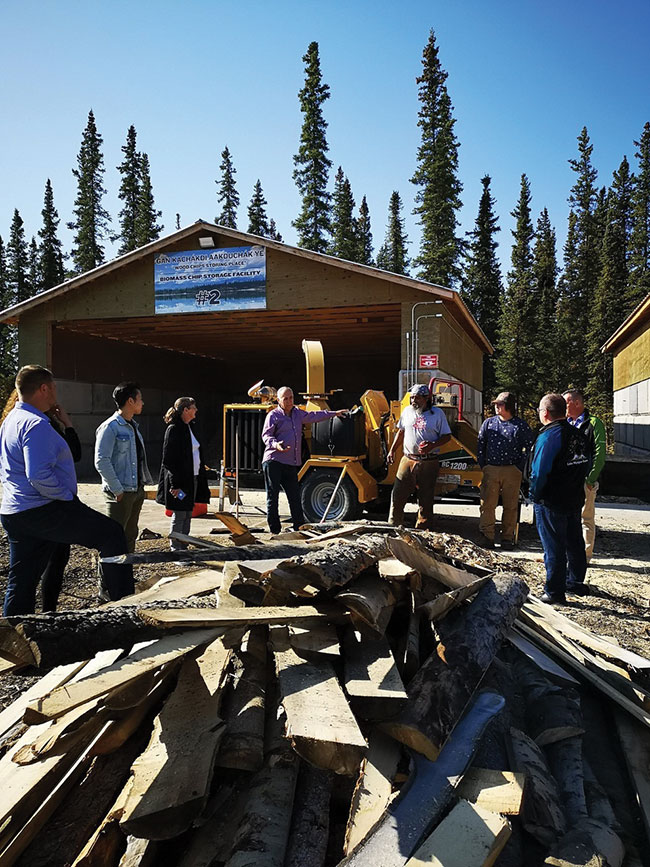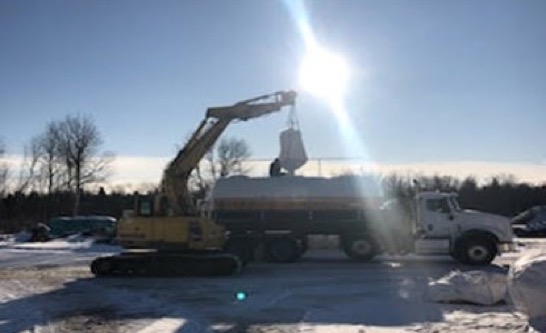
Remotely powerful: Nine rural communities’ experience with bioenergy – Part 3
August 11, 2020
By Sebnem Madrali and Jean Blair
A look at the communities’ biomass fuels and supply chains
 Log yard, chipper and bulk wood chip storage shed in Teslin. Photo courtesy Blair Hogan.
Log yard, chipper and bulk wood chip storage shed in Teslin. Photo courtesy Blair Hogan. [Editor’s note: this article is the third in a series of four. Find Part 1 here, and Part 2 here, and Part 4 here.]
In early 2020, CanmetENERGY, part of Natural Resources Canada, carried out interviews with nine pioneering rural and remote communities that have installed bioenergy systems to gain a better understanding of the challenges faced and what has or has not worked in terms of technologies, system design, fuel supply and storage and day-to-day operations. An article summarizing the communities and the factors that led to success was published in the Summer 2020 print edition of Canadian Biomass. This article is the third in a series of four articles based on the interviews and details the unique biomass fuel supply chains established in each community, as well as associated lessons and challenges. The second article covered the technical and operational aspects of the bioenergy systems and the fourth will cover training and capacity building.
Biomass energy systems require the establishment of local or regional biomass fuel supply chains that can generate meaningful local employment opportunities and drive economic development. Most community-scale biomass systems can operate efficiently using either wood chips or pellets. Thus, deciding what type of biomass fuel to use will depend on local availability and, for very remote communities, storage characteristics of biomass fuel over multiple heating seasons. Regardless of the fuel being used, quality and consistency are key to successful boiler operation.
The nine communities that were interviewed are split fairly evenly between wood pellets and wood chips/sawmill residues. Four communities use white wood pellets, while one very remote community uses black wood pellets. Of those that use wood chips or residues, one uses primarily sawdust from a nearby sawmill and three have established a local wood chip supply chain.
Wood pellet supply chains
In communities that do not have an active regional forest industry from which to source residues, wood pellets are a good alternative and usually result in cost savings compared to heating oil or diesel heating fuel. In the Northwest Territories, wood pellets are well-established as a heating fuel for public buildings and communities. The vast majority of the wood pellets consumed in the N.W.T. are supplied by La Crete Sawmills in northern Alberta. Several pellet distribution companies have also been established in larger population centres that offer regional bulk delivery. La Crete third-party tests their pellets regularly to ensure they meet the Pellet Fuels Institute (PFI) Premium Standard and therefore the requirements of the biomass heating systems.
The First Nations community Whati in the N.WT. receives bulk delivered wood pellets directly from La Crete once a year using the winter road. The pellets are stored in a large silo, with no reported issues of supply or degradation. In Ka’a’gee Tu First Nation, also in the N.W.T., a flex-fuel (log/pellet) boiler was installed with the hope of using cord wood that was harvested as part of a fire smart program (which would be free fuel). But loading the boiler manually was found to be too labour intensive, so the community switched to wood pellets as the primary fuel. Pellet deliveries are received regularly from a bulk distributor in Hay River, N.W.T.
Wiikwemkoong First Nation in Ontario is a unique case in that their decision to use pellets stemmed from community plans to develop a wood pellet plant nearby. Though the pellet plant has not yet been constructed, the community seized an opportunity to build local demand for wood pellets through Ontario’s Wood Heat Pilot Program. Pellets are currently sourced from Lacwood Pellets in Hearst, Ont., and transported to Wiikwemkoong in one tonne super sacks. To overcome the logistical challenges of storing and emptying sacks into the bulk delivery truck, the community has decided to install two 75-tonne silos for bulk storage. During its first heating season (in 2019/2020), the community experienced delays in supply on occasion when the pellet supplier recognized that the pellets did not meet the required quality standard and held back delivery.

Flat bed truck carrying super sacks of wood pellets and super sacks loaded to bulk pellet delivery truck, Wiikwemkoong, Ont.
The Gitxsan Nation in B.C. is currently using wood pellets supplied by Skeena Bioenergy in Terrace, B.C. Wood pellets are delivered to community installations, as well as residential customers, using the bulk pellet delivery truck owned and operated by Biomass Trade Centre, established by Gitxsan Energy Inc. This past winter was the Biomass Trade Centre’s first season of operation and it is in the process of establishing a local wood chip supply chain. Chips will be sourced from low-quality logs (not suitable for timber) from nearby forests managed by an external company for timber harvest. Logs will be stored and dried in a storage yard, then chipped and distributed.
Wood chip supply chains
Wood chip supply chains look quite different in the four communities interviewed that rely on them. Each is tailored to local conditions. In all cases, the source of the biomass feedstock is residue left after land clearing, forest fires or beetle infestation, or sawmill residues.
Ouje-Bougoumou Cree Nation in Quebec sources its biomass fuel – sawdust – from nearby Barrette-Chapais sawmill. The sawdust is picked up by a local who has a supply contract with the community. When the system first began operating in the 1990s, sawdust was available at extremely low cost. But, the cost has increased nearly tenfold in the decades since. Wood chips are being strongly considered as fuel going forward and the community is currently weighing the increased cost of wood chip fuel against savings in operation and maintenance costs using an economic model.
Northlands Denesuline First Nation in Manitoba sources its biomass from fire-killed wood in close proximity to the community. Northlands is located just south of the treeline, where trees are small and dense. Fires are fairly common and stems remain standing and intact after a fire goes through. The stems are harvested by locals using equipment they are familiar with (trucks, ATVs, snowmobiles, chainsaws), stored in a log yard and chipped on demand onto a walking floor in the energy house. The dry, dense logs are hard on the chipping equipment, so the community sourced a chipper that uses saw blades that can be sharpened as needed. The boiler and chipping operations are overseen by four locals who are able to visually determine when chips are getting too large and blades need to be sharpened.
Teslin Tlingit First Nation in the Yukon sources biomass primarily from logs that have been cleared from development land within the community. Logs are also purchased from about 20 private wood fuel suppliers, supplementing their income from residential firewood sales. They are stored and dried in a log yard, then chipped into the bulk storage shed, where fuel may be stored for up to two months before being loaded into the ‘day bins’ which feed the biomass boilers. The covered ‘day bins’ have concrete floors and can hold six to 10 days’ worth of fuel. The moisture content of the chips is tested regularly but the community is in the process of establishing a better system to monitor chip quality.
Kwadacha Nation in B.C. uses beetle-killed wood from nearby forests. The logs are harvested once a year by an external logging outfit (the community does not have logging equipment) and stored in a log yard. Logs are chipped on-demand directly into the bins that feed the biomass CHP units. When the system is operating at peak, the chipper runs almost non-stop and there are five to six locals employed full-time to oversee CHP and chipping operations. The community does not have a way to test or monitor moisture content but, in general, the beetle-killed wood has been dry. Green chips have been tested and do not work well with the gasification CHP technology. As a result of the dry biomass used, the chips have high fines content which has caused some issues with the CHP equipment. Funding has been secured to purchase a screen for the chipper and equipment to make briquettes from the fines.
Black pellet supply chain
Whapmagoostui Cree Nation in Quebec is located above treeline and thus does not have access to a local biomass. It uses black, or torrefied, wood pellets as fuel. The torrefied pellets are produced by Airex in Trois-Rivières, Que., and transported via winter access roads once a year in half-full containers (due to weight restrictions), which are then stored in a warehouse for up to two years. Both white and black wood pellets were tested and it was found that the black pellets stored better with no degradation during long-term storage (storage containers are sealed but temperature fluctuations caused condensation, turning white wood pellets to mush). The boilers were adjusted for black pellets prior to their installation. Samples are taken from each shipment to ensure quality is met.
Concluding remarks
Overall, each community has its own unique challenges related to fuel supply and developed approaches to overcome their challenges. While new jobs associated with the use of wood pellets are limited, notable employment and economic development opportunities can be created with bulk distribution. The existence of a cost-efficient, reliable supply of bulk wood pellet also enables the development of smaller scale systems than would otherwise be feasible. The establishment of local wood chip supply chains may initially be costly but results in significant local economic development, recirculation of money within the local economy and opportunities for capacity building. Torrefied pellets could be a good solution for communities above the treeline and are worth further exploration.
Read Part 4 of this series here.
Sebnem Madrali, Ph.D., is a senior research engineer at CanmetENERGY, Natural Resources Canada; her work focuses on advancing the development and implementation of heat and power generation from biomass and standardization of biomass fuels. Jean Blair, Ph.D., is a consultant and postdoctoral researcher who has been involved in biomass and bioenergy research for the past ten years, including the creation and maintenance of NRCan’s Canadian Bioheat Database.
This article is part of the Bioheat Week 2023. Read more articles about bioheat in Canada.
Print this page
